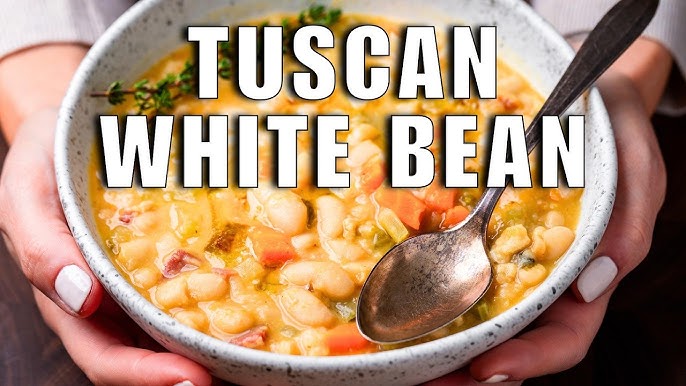White Bean Soup Recipe: Let’s be honest—there’s nothing quite like a warm bowl of soup to comfort you on a chilly day or to wind down after a long day. Soups are more than just a meal; they’re a hug in a bowl. Among the many variations, white bean soup earns a special place with its creamy texture, earthy flavor, and wholesome ingredients. Whether you’re a seasoned cook or a beginner just getting the hang of a ladle, this white bean soup recipe is easy, affordable, and absolutely delicious. It’s packed with protein, fiber, and warmth, making it a go-to dish for families, solo diners, and anyone looking to eat better without sacrificing flavor.
Ingredients Needed for White Bean Soup
Core Ingredients
To get started, you don’t need anything fancy. This is one of those magical recipes where simple pantry staples shine bright.
- White beans (cannellini or navy beans) – 1½ cups dried (or 2 cans, rinsed)
- Onions – 1 large, chopped
- Garlic – 4 cloves, minced
- Carrots – 2 medium, diced
- Celery – 2 stalks, chopped
- Olive oil – 2 tablespoons
- Vegetable broth or chicken broth – 4 cups
- Bay leaf – 1
- Salt and black pepper – To taste
- Thyme (dried or fresh) – ½ teaspoon
- Parsley or rosemary – For garnish
Optional Add-ins
Want to elevate your soup? Add a few extras:
- Smoked paprika or crushed red pepper flakes for heat
- Kale or spinach for a veggie boost
- Parmesan rinds for extra depth
- Bacon or pancetta if you eat meat and want a savory twist
Ingredient Substitutions for Dietary Needs
- Use gluten-free broth if you’re avoiding gluten.
- For a vegan version, stick to vegetable broth and skip any meat or cheese.
- Swap coconut oil or avocado oil for olive oil if you have dietary restrictions.
Kitchen Tools You’ll Need
Basic Cooking Tools
You don’t need a professional kitchen to whip up this soup. Just gather:
- A large soup pot or Dutch oven
- Knife and cutting board
- Wooden spoon for stirring
- Measuring cups and spoons
Optional but Helpful Tools
- Immersion blender (if you want a creamy texture)
- Ladle for serving
- Storage containers for leftovers
These tools help keep your cooking process smooth and your soup silky if you prefer it blended.
Step-by-Step Guide to Making White Bean Soup
Step 1: Soaking and Preparing the Beans
If you’re using dried beans, soak them overnight in a large bowl with enough water to cover them by several inches. This helps reduce cooking time and improve digestion. The next day, drain and rinse them before cooking. If you’re in a rush, canned beans are a great alternative—just make sure to rinse them well to remove excess sodium and preservatives.
Pro Tip: Add a pinch of baking soda to the soaking water to help soften the beans more efficiently.
Step 2: Sautéing the Aromatics
This is where flavor starts to build. In your soup pot, heat the olive oil over medium heat. Add chopped onions, garlic, carrots, and celery. Stir frequently and let them sweat until they soften and the onions are translucent—about 5-7 minutes.
Don’t rush this step. This mix is your mirepoix, the French foundation for many great dishes. It’s what will give your soup that “cooked-all-day” taste in a fraction of the time.
Step 3: Building the Soup Base
Once your veggies are soft and fragrant, toss in your soaked beans (or canned), broth, thyme, bay leaf, and a good pinch of salt and pepper. Bring it to a boil, then reduce the heat to low. Cover the pot and let it simmer for about 1 to 1.5 hours if using dried beans. If you’re using canned beans, 30 minutes is plenty.
As the soup simmers, the beans will get tender, and all the flavors will start to meld together beautifully. Stir occasionally to prevent sticking.
Optional Add-In Tip: Now is the time to add any additional veggies like kale or spinach. Toss them in during the last 15 minutes so they stay vibrant and nutritious.
Step 4: Simmering for Flavor Development
Patience really pays off here. As your soup simmers, the ingredients will marry into a rich, cozy broth. If you’re using parmesan rinds or a bit of pancetta, throw them in now for a deeper, umami-rich profile. Just be sure to remove them before serving.
Taste test toward the end of the cook time and adjust seasoning as needed—sometimes a squeeze of lemon juice or a dash of vinegar at the end brings everything to life!
Step 5: Blending (Optional) and Final Seasoning
Now for the fun part—texture. If you like your soup thick and creamy, use an immersion blender to partially or fully puree the soup. You can also scoop out a few cups, blend in a regular blender, and return it to the pot.
Love it chunky? Skip this step and enjoy the rustic charm.
Don’t forget the final seasoning. Add extra salt, pepper, or a little smoked paprika if needed. Top with fresh herbs and a drizzle of olive oil or a sprinkle of grated cheese for a beautiful finish.
Serving Suggestions
Best Pairings with White Bean Soup
Serve your white bean soup with:
- Crusty bread or a slice of sourdough
- Grilled cheese sandwich for comfort food heaven
- Side salad for a lighter meal
Garnishing Ideas for Presentation
Elevate your bowl with:
- Fresh parsley, rosemary, or thyme
- A swirl of cream or olive oil
- Toasted croutons or parmesan shavings
Storing and Reheating White Bean Soup
How to Store It Properly
One of the best things about white bean soup is that it stores beautifully, making it a great make-ahead meal. Let the soup cool completely before transferring it to airtight containers. You can store it in the refrigerator for up to 5 days, or freeze it for up to 3 months.
When freezing, use containers that leave a little space at the top for expansion. You can also portion the soup into freezer bags and lay them flat for efficient storage.
Quick Tip: Label your containers with the date so you always know how fresh it is.
Best Reheating Methods
To reheat from the fridge, just pour the soup into a pot and warm over medium heat, stirring occasionally. If the soup has thickened too much, add a splash of broth or water to bring it back to your preferred consistency.
For frozen soup, let it thaw overnight in the fridge before reheating. You can also reheat it directly from frozen on low heat—it just takes a bit longer.
Microwaving is also an option: heat in short bursts (1-2 minutes), stirring in between, to ensure even heating.
Health Benefits of White Bean Soup
Packed with Nutrients
White beans are small but mighty. They’re a fantastic source of plant-based protein, making this soup ideal for vegetarians or those looking to cut back on meat. They also provide:
- Fiber – Keeps your digestive system happy
- Iron – Supports healthy blood cells
- Magnesium and potassium – Great for heart health
- Folate – Important for cell repair and brain health
Add in the garlic, carrots, celery, and herbs, and you’re looking at a seriously nutrient-dense bowl of goodness.
Great for Weight Management and Gut Health
Thanks to the high fiber content, this soup helps you feel fuller longer, curbing unnecessary snacking. Plus, the complex carbs in beans give you sustained energy without spiking blood sugar levels. Your gut bacteria also love the fiber—it’s a win-win all around.
Variations of White Bean Soup
Mediterranean White Bean Soup
Add tomatoes, oregano, and spinach. Serve with a wedge of lemon and feta cheese on top for a bright and tangy twist.
Smoky White Bean and Sausage Soup
Incorporate smoked sausage or chorizo and a bit of smoked paprika. The result? A rich, deeply flavored soup that’s extra hearty.
Italian-Style White Bean Soup
Use rosemary, thyme, and a parmesan rind while simmering. Top with grated parmesan and serve with garlic bread for a classic Italian feel.
Vegan Creamy White Bean Soup
Use coconut milk or cashew cream for a rich and creamy finish without any dairy. Add nutritional yeast for a cheesy flavor boost.
Tips for the Perfect White Bean Soup
Use Homemade Broth If Possible
A homemade broth will always give your soup a deeper flavor. If using store-bought, opt for low-sodium versions so you can control the salt level yourself.
Taste As You Go
Soups change as they simmer. Always taste toward the end of cooking and adjust with salt, pepper, acid (like lemon juice or vinegar), or even a pinch of sugar if your broth is too bitter.
Don’t Skip the Garnish
Even a sprinkle of herbs or a splash of olive oil makes your soup look more inviting and taste more gourmet.
FAQs about White Bean Soup Recipe
Can I use canned white beans instead of dried beans?
Absolutely! Canned white beans are a convenient shortcut. Just rinse and drain them before adding to the soup. They cut down cooking time significantly.
What kind of white beans should I use?
Great Northern beans, navy beans, or cannellini beans all work beautifully. Cannellini beans are slightly creamier, while navy beans are smaller and cook faster.
Can I make this soup vegan?
Yes! Swap out any meat-based broth for vegetable broth, and skip any meat ingredients like bacon or sausage. It’ll still be hearty and flavorful.
How long does white bean soup last in the fridge?
Stored in an airtight container, it keeps for about 4–5 days. The flavors get even better the next day—hello, leftovers!
Can I freeze white bean soup?
You bet! Let it cool completely, then freeze in portions for up to 3 months. Reheat gently on the stovetop or in the microwave.
What can I serve with white bean soup?
Crusty bread, garlic toast, or a side salad make great companions. Want to level it up? Top your bowl with grated Parmesan or a drizzle of olive oil.
Conclusion
White bean soup is the perfect example of how simple ingredients can come together to make something truly comforting and nutritious. Whether you’re cooking it on a lazy weekend or prepping meals for a busy week, this soup is your secret weapon for delicious, easy, and wholesome eating.
From soaking the beans to simmering the pot, every step is straightforward but full of flavor potential. Customize it to your taste, freeze the leftovers, and enjoy a satisfying meal anytime. Now that you have the ultimate guide, it’s time to grab a pot and get cooking. Trust me—your future self will thank you.



